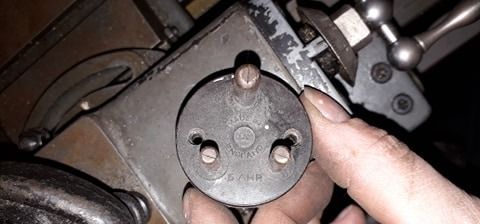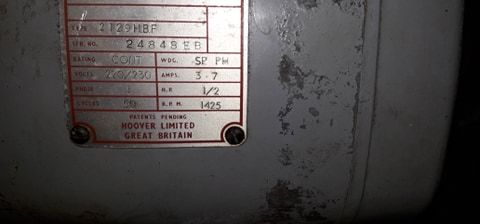Member postings for James Hemmingham
Here is a list of all the postings James Hemmingham has made in our forums. Click on a thread name to jump to the thread.
| Thread: Fixing motor for Myford Ml7 |
| 24/03/2020 21:19:03 |
Posted by Harry Wilkes on 24/03/2020 15:37:04:
In the olden days they were two sizes of plug the one shown in your pic rated at 5A then there was a larger version of that type of round plug rated at 15A, then with the coming of the ring main 13A became the standard . Have not read all post's but have you tried disconnecting the motor to see if the fuse blows ? H
|
| 24/03/2020 21:15:50 |
Posted by SillyOldDuffer on 24/03/2020 16:02:50:
Posted by James Hemmingham on 24/03/2020 14:34:31:. ... It puzzles me that the original plug says 5A on it, can anyone offer an explanation? The round-pin style came in 4 different sizes: 2A, 5A, 15A and 30A. Before square pin plugs and sockets, UK domestic wiring was wired on a spur system where each socket connected back to a separate fuse. Spurs could be of different current capacities and to stop people burning the house down different sized plugs were used to make sure a 2A device couldn't be plugged into a 30A spur, or a 30A device into a 15A spur. No need for round-pin plugs to contain a fuse because there was one in the fuse box. The spur system was fine when people only needed a few sockets, but it's inconvenient in a modern home. In 1947 the system changed to wire houses with ring mains rather than spurs. A ring main can have many sockets connected to it, which suits modern needs. Although the main is protected by a single big fuse, each appliance needs to have a fused plug. All square-pin plugs are the same physical size, but they can be fitted with different fuses as necessary to suit the appliance. I have 1A, 2A, 3A, 5A, 7A and 13A examples, but 3 and 13A are the most common. A 13A plug and fuse would be OK for a Myford. Maybe the lathe should never have been fitted with a 5A plug, but not all lathe owners were electricians! Sparey's "The Amateur's Lathe' is well worth reading. Excellent book apart from things like carbide inserts that came later, but his comments on 1950's home workshop electrics make it clear that quite a few chaps back then lived dangerously! It's not a problem though : the wiring and switches etc could all be replaced if necessary. Dave
That's really interesting thanks. The plug must be ancient. |
| 24/03/2020 14:34:31 |
Thank you for your replies everyone. "One of the disadvantages of buying elderly second-hand equipment is the electrics might well be in poor condition, or not in accord with today's best practice. Damp, damaged, perished, unprotected etc etc. Not a problem because it can be upgraded without fuss, probably adding a NVR in the process. Assuming the machine is a bit dodgy, can the experts advise what James should look for and how he can test for electrical faults? At the moment, for all we know, this old Myford isn't even earthed..." |
| 23/03/2020 18:46:59 |
Hello,
|
Want the latest issue of Model Engineer or Model Engineers' Workshop? Use our magazine locator links to find your nearest stockist!
Sign up to our newsletter and get a free digital issue.
You can unsubscribe at anytime. View our privacy policy at www.mortons.co.uk/privacy
- *Oct 2023: FORUM MIGRATION TIMELINE*
05/10/2023 07:57:11 - Making ER11 collet chuck
05/10/2023 07:56:24 - What did you do today? 2023
05/10/2023 07:25:01 - Orrery
05/10/2023 06:00:41 - Wera hand-tools
05/10/2023 05:47:07 - New member
05/10/2023 04:40:11 - Problems with external pot on at1 vfd
05/10/2023 00:06:32 - Drain plug
04/10/2023 23:36:17 - digi phase converter for 10 machines.....
04/10/2023 23:13:48 - Winter Storage Of Locomotives
04/10/2023 21:02:11 - More Latest Posts...
- View All Topics
- Reeves** - Rebuilt Royal Scot by Martin Evans
by John Broughton
£300.00 - BRITANNIA 5" GAUGE James Perrier
by Jon Seabright 1
£2,500.00 - Drill Grinder - for restoration
by Nigel Graham 2
£0.00 - WARCO WM18 MILLING MACHINE
by Alex Chudley
£1,200.00 - MYFORD SUPER 7 LATHE
by Alex Chudley
£2,000.00 - More "For Sale" Ads...
- D1-3 backplate
by Michael Horley
Price Not Specified - fixed steady for a Colchester bantam mark1 800
by George Jervis
Price Not Specified - lbsc pansy
by JACK SIDEBOTHAM
Price Not Specified - Pratt Burnerd multifit chuck key.
by Tim Riome
Price Not Specified - BANDSAW BLADE WELDER
by HUGH
Price Not Specified - More "Wanted" Ads...
Do you want to contact the Model Engineer and Model Engineers' Workshop team?
You can contact us by phone, mail or email about the magazines including becoming a contributor, submitting reader's letters or making queries about articles. You can also get in touch about this website, advertising or other general issues.
Click THIS LINK for full contact details.
For subscription issues please see THIS LINK.
Model Engineer Magazine
- Percival Marshall
- M.E. History
- LittleLEC
- M.E. Clock
ME Workshop
- An Adcock
- & Shipley
- Horizontal
- Mill
Subscribe Now
- Great savings
- Delivered to your door
Pre-order your copy!
- Delivered to your doorstep!
- Free UK delivery!











 Register
Register Log-in
Log-in


